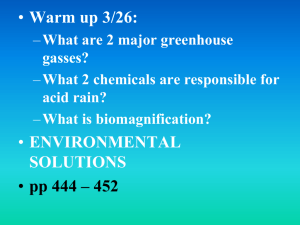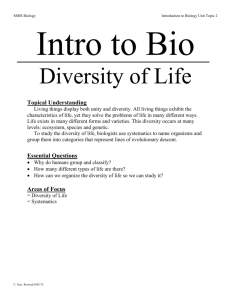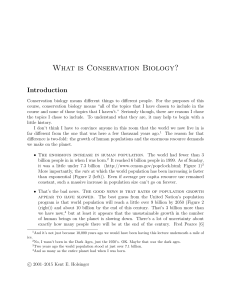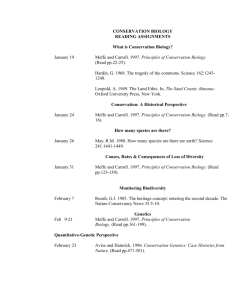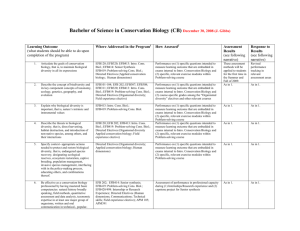Kent State University Department of Biological Sciences Bachelor of
advertisement
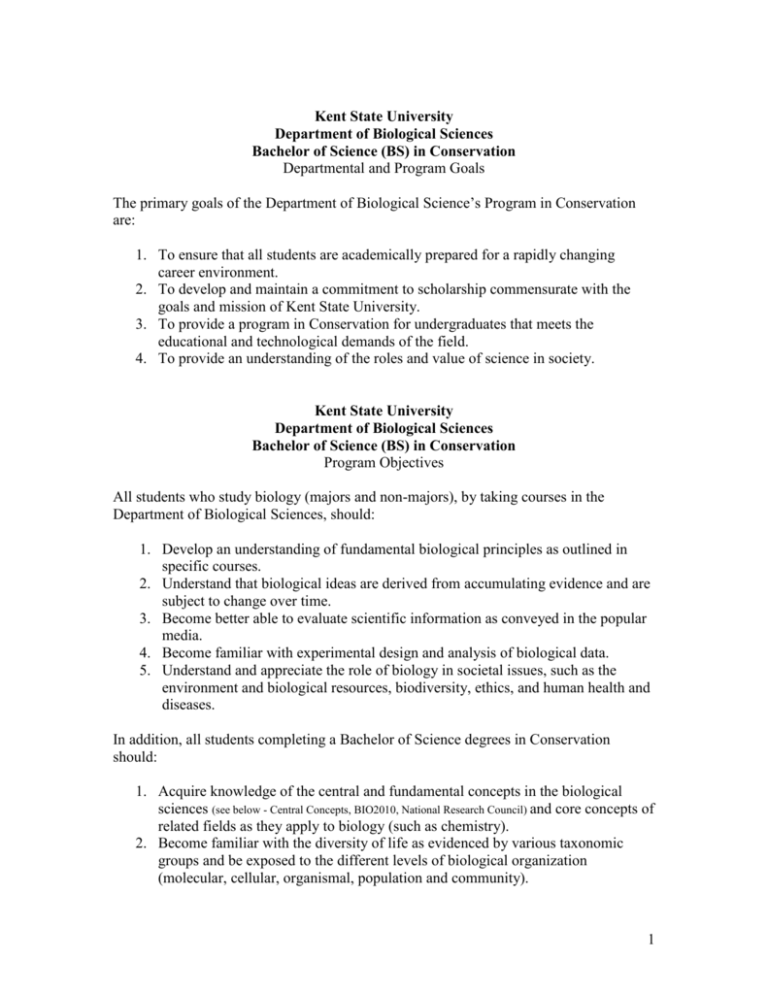
Kent State University Department of Biological Sciences Bachelor of Science (BS) in Conservation Departmental and Program Goals The primary goals of the Department of Biological Science’s Program in Conservation are: 1. To ensure that all students are academically prepared for a rapidly changing career environment. 2. To develop and maintain a commitment to scholarship commensurate with the goals and mission of Kent State University. 3. To provide a program in Conservation for undergraduates that meets the educational and technological demands of the field. 4. To provide an understanding of the roles and value of science in society. Kent State University Department of Biological Sciences Bachelor of Science (BS) in Conservation Program Objectives All students who study biology (majors and non-majors), by taking courses in the Department of Biological Sciences, should: 1. Develop an understanding of fundamental biological principles as outlined in specific courses. 2. Understand that biological ideas are derived from accumulating evidence and are subject to change over time. 3. Become better able to evaluate scientific information as conveyed in the popular media. 4. Become familiar with experimental design and analysis of biological data. 5. Understand and appreciate the role of biology in societal issues, such as the environment and biological resources, biodiversity, ethics, and human health and diseases. In addition, all students completing a Bachelor of Science degrees in Conservation should: 1. Acquire knowledge of the central and fundamental concepts in the biological sciences (see below - Central Concepts, BIO2010, National Research Council) and core concepts of related fields as they apply to biology (such as chemistry). 2. Become familiar with the diversity of life as evidenced by various taxonomic groups and be exposed to the different levels of biological organization (molecular, cellular, organismal, population and community). 1 3. Master the basic skills necessary for laboratory and field investigations and have experience in designing investigations, collecting data, and analyzing results. 4. Use oral and written expression to communicate research results and biological concepts in an effective manner and use the primary literature with proper interpretation and citation. 5. Have the opportunity to explore selected areas of conservation in depth in advanced courses and/or through independent research investigation or an honors thesis. 6. Learn the content knowledge of conservation (and related sciences) necessary for the career path identified by the student (entering the workforce, graduate schools, and professional schools) 7. Grow in intellectual ability, enhance problem-solving skills, and improve higherlevel reasoning skills for advanced study or work in the biological sciences. Concepts of Biology –The committee on Undergraduate Biology Education to Prepare Research Scientists for the 21st Century, National Research Council, identified the following central themes of biology that should be learned by all biology students. These serve as the departmental guide for course content, particularly in the core courses. Central Themes 1. All living things have evolved from a common ancestor, through processes that include natural 2. 3. 4. 5. 6. 7. 8. 9. 10. 11. 12. 13. selection and genetic drift acting on heritable genetic variation. Biological systems obey the laws of chemistry and physics. Structural complexity and information content are built up by combining simpler subunits into multiple complex combinations. Understanding biological systems requires both reductionist and holistic thinking because novel properties emerge as simpler units assemble into more complex structures. Living systems are far from equilibrium. They utilize energy, largely derived from photosynthesis, which is stored in high-energy bonds or ionic concentration gradients. The release of this energy is couple to thermodynamically unfavorable reactions to drive biological processes. Although fundamental molecular and cellular processes are conserved, biological systems and organisms are extraordinarily diverse. Unlike atoms and simple molecules studied in chemistry and physics, no two cells are identical. Biological systems maintain homeostasis by the action of complex regulatory systems. These are often networks of interconnecting partially redundant systems to make them stable to internal or external changes. Cells are fundamental units of living systems. Three fundamental cell types have evolved: bacteria, archea, and eukaryotes. Living organisms have behavior, which can be altered by experience in many species. Information encoded in DNA is organized into genes. These heritable units use RNA as informational intermediates to encode protein sequences, which become functional on folding into distinctive three-dimensional structures. In some situations, RNA itself has catalytic activity. Most biological processes are controlled by multiple proteins, which assemble into modular units to carry out and coordinate complex functions. Lipids assemble with proteins to form membranes, which surround cells to separate them from their environment. Membranes also form distinct compartments within eukaryotic cells. Communication network within and between cells, and between organisms, enable multicellular organisms to coordinate development and function. 2 14. In multicellular organisms, cells divide and differentiate to form tissues, organs, and organ systems with distinct functions. These differences arise primarily from changes in gene expression. 15. Many diseases arise from disruption of cellular communication and coordination by infection, mutation, chemical insult, or trauma. 16. Groups of organisms exist as species, which include interbreeding populations sharing a gene pool. 17. Populations of species interact with one another and the environment to form interdependent ecosystems with flow of energy and materials between multiple levels. 18. Humans, as well as many other species, are members of multiple ecosystems. They have the capacity to disrupt or preserve the ecosystems upon which they depend . - Excerpted from BIO2010: Transforming Undergraduate Education for Future Research Biologists, Committee on Undergraduate Biology Education to Prepare Research Scientists for the 21st Century, National Research Council. 2003. 3
